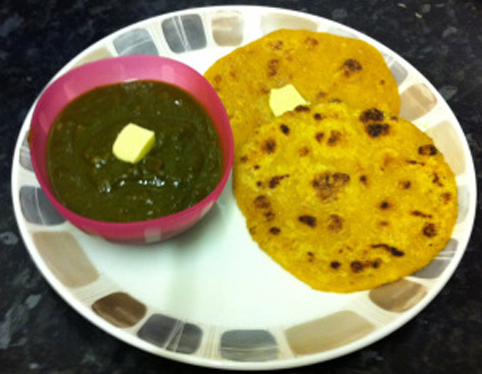Mama’s Punjabi Recipes – Makki di Roti (Corn Flour Bread)
Last week I gave the recipe for sarson ka saag (mashed mustard greens), a dish that is synonymous with home-cooked Punjab food and I mentioned that it is typically eaten with thick makki di roti (stone-ground, coarse corn flour bread). With some homemade mango pickles and finished off with some lassi (buttermilk), the meal has the right mix of deep country flavors and tangy spiciness!
Makki di roti is yellow in color when it is ready and is more difficult to make than regular wheat flour bread as it has much less adhesive strength. Steel-ground yellow cornmeal is most commonly found in the US and has most of the husk and germ of the maize kernel almost completely removed. Stone-ground cornmeal, found in most Indian stores, retains some of the hull and germ, giving it more flavor and nutrition.
Also, I mentioned that the two dishes are usually eaten during the cold harvesting months when whole fields are harvested in the Punjab for the corn and mustard greens. The meal gives that burst of energy to ward off the winter chills! If the whole meal is finished off with a gur (rock molasses) or chinni di (sugar) gajak (crackle), it makes for a great combination. When served hot, a spoonful of butter is placed on the bread to add to the rustic quality of the meal. But be careful, you can easily eat too much of the tasty meal!
There are two secrets to making good makki di roti: first you cannot roll the dough into a pancake like wheat flour roti – you must use a lay-down cloth and second, you must use enough oil to coat your hands and the tava so that the dough does not stick. The oil also helps to make the dough crisp. The ajawain (bishop’s weed or carom seeds) is added to help in the digestion.
Ingredients:
• 500 gm makki da atta (stone-ground yellow cornmeal)
• 4 cups pani (water)
• ½ cup tael (olive oil or vegetable oil)
• 1 tsp ajawain (bishop’s weed or carom seeds)
• Spices (to taste): namak (salt)
Directions:
1. In a pot, warm the water over the stove. Warm water lets the cornmeal rise easily.
2. Place the cornmeal flour in a pan along with the salt and ajawain and add the warm water, a little at a time, to knead it into atta (dough). After it is made, dab the dough with a little bit of water so that it does not dry out.
3. Place a little oil on your hands and rub to grease your palms. Pinch off a small amount of dough and make it round between the palms, dabbing a little water on it to make it easier to roll.
4. Now place a 12 inch square piece of muslin cloth or soft tissue on the counter. Place the round dough on the cloth and press down gently with the rear portion of the palm so as to make the dough spread into a 5 inch disk.
5. Place the tava (flat or slightly spherical skillet) on the stove and heat well. Coat with a half-teaspoon of oil and then lift the cloth; placing the dough gently on the tava. Lift back the cloth and place it on the counter to make the next dough pancake and repeat the step over the tava.
6. When the roti starts to look a bit dry, flip it over with a spatula and add a little oil to the tava. Once it is dry, flip again, and add a tiny bit of oil. The roti is ready when some dark spots appear on each side and it becomes a little crisp. Unlike the wheat flour roti, the makki di roti will not puff up and rise.
7. Once you have enough practice with this, you can try adding some grated mooli (long white radishes) or methi (fenugreek) to the dough balls and then press them in the same way into a pancake and cook the roti the same way. The taste is very unique and delicious and these can even be eaten with some plain yogurt.
8. This dish is best served with makki di roti (corn flour chappatis) in a typical Punjabi fashion. I will write that recipe next week.
Shakuntla Malhotra is a skilled cook of Punjabi dishes made in the old-fashioned style that she learnt as a young woman in her ancestral home in Lyallpur, India before it became part of Pakistan after the Partition in 1947. People have often admired her cooking for its simplicity and taste that comes with each mouthful. Even in her mid-eighties, she continues to cook daily and agreed to share some of her delectable Punjabi recipes.

